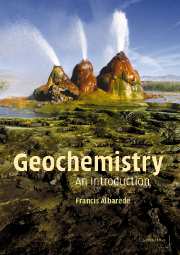Book contents
- Frontmatter
- Contents
- Foreword to the English edition
- Foreword to the French edition
- Acknowledgments
- Introduction
- 1 The properties of elements
- 2 Mass conservation – elemental and isotopic fractionation
- 3 Geochronology and radiogenic tracers
- 4 Element transport
- 5 Geochemical systems
- 6 Waters present and past
- 7 Mineral reactions
- 8 The solid Earth
- 9 The Earth in the Solar System
- 10 The geochemical behavior of selected elements
- Appendix A Composition of the major geological units
- Appendix B The mixing equation for ratios
- Appendix C A refresher on thermodynamics
- Appendix D The Rayleigh distillation equation
- Appendix E The geological time scale
- Appendix F An overview of analytical methods
- Appendix G Physical and geophysical constants
- Appendix H Some equations relative to residence time
- Further reading
- Index
4 - Element transport
- Frontmatter
- Contents
- Foreword to the English edition
- Foreword to the French edition
- Acknowledgments
- Introduction
- 1 The properties of elements
- 2 Mass conservation – elemental and isotopic fractionation
- 3 Geochronology and radiogenic tracers
- 4 Element transport
- 5 Geochemical systems
- 6 Waters present and past
- 7 Mineral reactions
- 8 The solid Earth
- 9 The Earth in the Solar System
- 10 The geochemical behavior of selected elements
- Appendix A Composition of the major geological units
- Appendix B The mixing equation for ratios
- Appendix C A refresher on thermodynamics
- Appendix D The Rayleigh distillation equation
- Appendix E The geological time scale
- Appendix F An overview of analytical methods
- Appendix G Physical and geophysical constants
- Appendix H Some equations relative to residence time
- Further reading
- Index
Summary
The theory of element transport is a way of representing the spatial changes in geochemical properties in various contexts, such as movement in the ocean or mantle, the migration of geological fluids or magmatic liquids within a rock matrix, or the attainment of chemical and isotopic equilibrium among minerals within the same rock, etc. It is, in fact, a set of rather complex theories involving some heavyweight mathematics, which we can only touch lightly upon in this book.
The essential concepts forming the core of this theory are those of conservation, flux, sources, and sinks. A conservative property is additive and can only be altered by addition or subtraction at the system boundaries or by the presence of sources and sinks. Mass or number of moles are conservative properties; concentration is not: if a mole of salt is added to a solution already containing one mole, the resulting solution will contain two moles, however the salt is added and whatever the volume of the system. In contrast, two solutions of one mole per liter combine to form a solution of one mole per liter. A flux is a quantity of something (mass, moles, energy, etc.) crossing a unit surface per unit time. The most familiar of these fluxes is volume flow, which is quite simply the velocity v (in cubic meters per square meter per second). Mass flux is the mass content of volume flow, i.e. ρv, where ρ is the density of the medium.
- Type
- Chapter
- Information
- GeochemistryAn Introduction, pp. 69 - 80Publisher: Cambridge University PressPrint publication year: 2003

